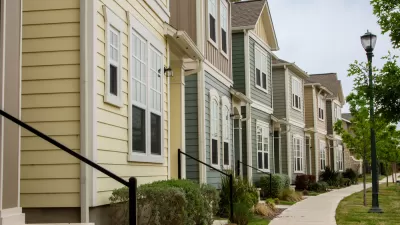New research shows that reducing lot size requirements helped create thousands of new homes.

A new study from the University of Texas at Austin, sponsored by The Pew Charitable Trusts, analyzes how reducing minimum lot size requirements in Houston, Texas impacted the city’s housing stock.
As a brief from Pew explains, “Rules that allow only detached houses on large lots are often at the center of debates about zoning, and this study helps to shed light on how land-use reform affects urban residential neighborhoods.”
The study’s findings “suggest that SF2TH conversions helped to increase the number of available homes—and therefore households—in high-demand areas without driving out existing residents, belying a claim commonly made by opponents of land-use reform that new development in dense urban communities would lead to gentrification.”
Houston reduced its lot size requirement from 5,000 square feet to 3,500 square feet in 1998, expanding that ordinance to almost the entire city in 2013, leading to a rise in the construction of smaller, more affordable town houses.
The study concludes that “Land-use reforms can spur housing development” and “often have only incremental impacts on the physical character of residential neighborhoods.” Furthermore, in Houston, “Adding more housing did not displace residents.” The study found that “Ultimately, allowing enough housing for everyone enabled affordability and reduced displacement pressures.”
FULL STORY: Lot-Size Reform Unlocks Affordable Homeownership in Houston

Planetizen Federal Action Tracker
A weekly monitor of how Trump’s orders and actions are impacting planners and planning in America.

San Francisco's School District Spent $105M To Build Affordable Housing for Teachers — And That's Just the Beginning
SFUSD joins a growing list of school districts using their land holdings to address housing affordability challenges faced by their own employees.

The Tiny, Adorable $7,000 Car Turning Japan Onto EVs
The single seat Mibot charges from a regular plug as quickly as an iPad, and is about half the price of an average EV.

With Protected Lanes, 460% More People Commute by Bike
For those needing more ammo, more data proving what we already knew is here.

In More Metros Than You’d Think, Suburbs are Now More Expensive Than the City
If you're moving to the burbs to save on square footage, data shows you should think again.

The States Losing Rural Delivery Rooms at an Alarming Pace
In some states, as few as 9% of rural hospitals still deliver babies. As a result, rising pre-term births, no adequate pre-term care and "harrowing" close calls are a growing reality.
Urban Design for Planners 1: Software Tools
This six-course series explores essential urban design concepts using open source software and equips planners with the tools they need to participate fully in the urban design process.
Planning for Universal Design
Learn the tools for implementing Universal Design in planning regulations.
Smith Gee Studio
City of Charlotte
City of Camden Redevelopment Agency
City of Astoria
Transportation Research & Education Center (TREC) at Portland State University
US High Speed Rail Association
City of Camden Redevelopment Agency
Municipality of Princeton (NJ)





























